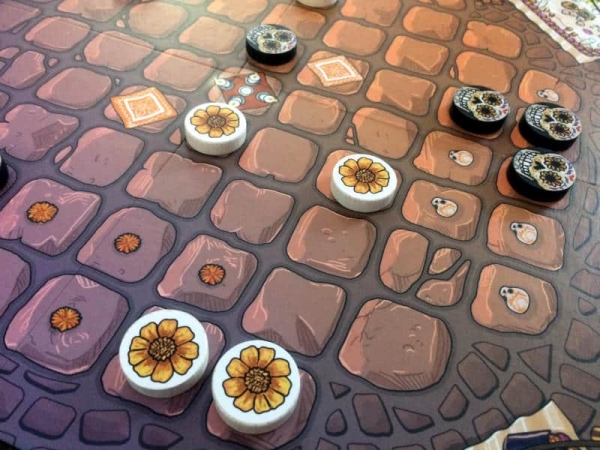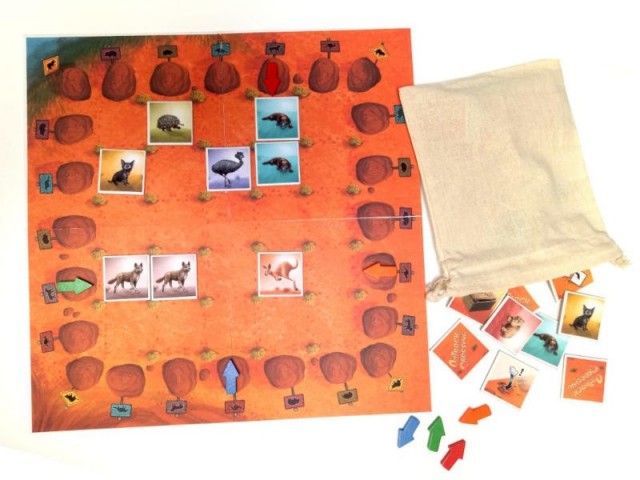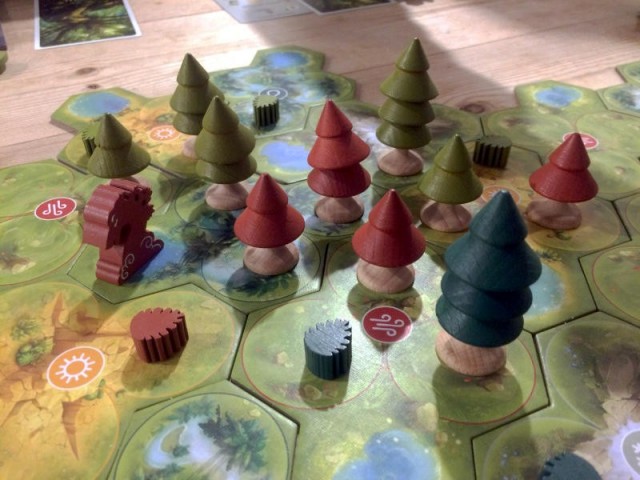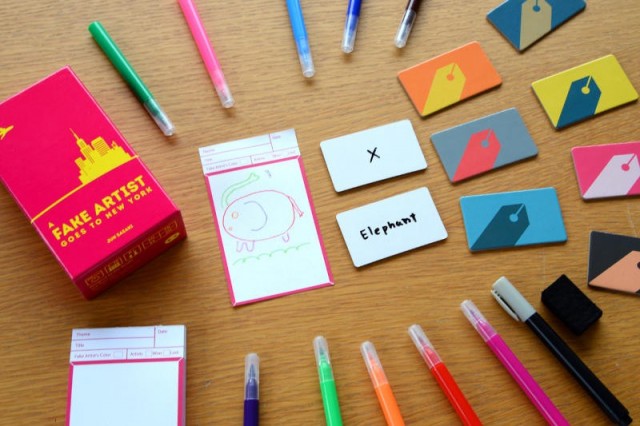It was time for our annual harvest and for the Day of the Dead. We are all looking forward to seeing the souls of our dead loved ones again. There would be dancing, singing, drinking, eating and general merriment. It was going to be our chance to speak with our long-deceased family members again. This year it was going to be different though. We would make a bet with the dead. It would be a race. Whoever made it back to their world again first would control what happened in the other realm for a whole year. We were ready to say ¡Adiós Calavera! by Martin Schlegel from Mücke Spiele.
Lovely Lively Look
OK. The overall theme of a race between the dead and the living to decide who rules the other's realm for a year is quirky, but at the end of the day, ¡Adiós Calavera! is simply an abstract strategy game that feels very much like Chinese Checkers, except that it's for only two players and introduces special powers to some of your tokens. At the same time though, the theme makes for wonderful artwork and a general look. Christian Opperer's illustrations are rather magical and their cartoon style draws you in. It's definitely a wonderful game to look at.
Generally speaking, the game as a whole is really lovely. The wooden discs that represent the living or the dead are a good weight. There are sticker sheets, which you only really need to apply if you want to take advantage of some of the advanced rules that allow you to apply special powers to some of your tokens. I recommend you do apply them in any case though, because they really elevate the otherwise plain black and white discs and make the game so much more enjoyable.
The box is also a good size, not being too generous with the amount of air. You can easily put everything away and components do rattle around a little, but it's not like half the box is empty. It's clearly the game board that decided how big the box had to be, which is often the case, but I think Mücke Spiele came up with a good compromise. If you wanted the packaging to be any smaller, you'd have to look at printing the play area onto neoprene or similar and roll it up. However, I think it works as it is.
Adiós Movement
Let's get to the meat of the game though. As I mentioned at the top, despite its theme, ¡Adiós Calavera! is an abstract, two-player strategy game. I was immediately reminded of Chinese Checkers from my youth. Your goal is to get all of your counters across the board and off the other edge. You play on a square board, with one player aligning their tokens in two rows along one edge, while the other player places theirs in a similar fashion, but perpendicular to the first player. So you're not opposite each other, but at right angles.
It's how you move your tokens that's the most interesting part though. I've not seen this mechanism before. As you would expect, you move forward, backwards or sideways, but not diagonally. That's not unusual. What is different is how many spaces you move. That is decided by the number of counters in the same row as the one you want to move. I say "row", but what is a row for one player will be a column for the other player, because you're both playing at right angles to each other.
So let's say you're playing white and in the same row as the disc you want to move are two other white as well as one black disc. That's a total of four discs, including the one you want to move. That means you can move your token up to four spaces horizontally or vertically. It sounds great, but here comes the rub. While your tokens will be able to move a long way to start with, because there are plenty of other tokens in the same row, once they have moved ahead, they will be on their own. Suddenly they can only move one space.
 Applying the stickers to the wooden discs really elevates the game experience
Applying the stickers to the wooden discs really elevates the game experience
Dicing with Death
So keeping your counters together is often important to ensure you can still move a good way ahead. At the same time, how far ahead you move is also very important. If you can cleverly line up your tokens with those of your opponent, then you'll get an extra boost. It's this positive player interaction in ¡Adiós Calavera! that's really nice to see. There isn't really much negative player interaction either. You can't take the other player's pieces. The worst you can do is try and block theirs. However, chances are that your blocking piece will still give extra movement to another of your opponent's discs.
As you can tell, the more you play ¡Adiós Calavera!, the more interesting strategies and tactics you discover. Even when you think you mastered it, you can ramp it up another level and add unique powers. Each of your eight tokens can be flipped over to represent a special ability for that disc. Both players have the same eight powers to choose from. The rules recommend that both players choose four discs and put them on their advanced side, leaving the other four on their normal side. Now some of your counters can pull other counters in, like a magnet, or they can move diagonally, giving them a huge movement boost. There are lots of interesting options to choose from.
These special abilities really change the game up. They open up a whole new wealth of strategies and tactics. You sort of have to relearn the game and adjust how you play. Some of the extra powers need to be applied at just the right time, which can be difficult. So, no, don't fear. ¡Adiós Calavera! will keep you entertained for a long time to come.
Skulls
So don't be deceived. When I first looked at ¡Adiós Calavera!, I thought it would be a simple variant of Chinese Checkers. However, it's a really different game. I played it a lot with my wife while we were on holiday and we both really enjoyed it. It scratches a lot of different two-player abstract strategy game itches. There is enough strategy and tactics that reminds you of Chess, without being quite so complex and demanding. There is a clear Checkers feel about the game, but it's also very different. It presents an interesting challenge that can play out in about half an hour or less.
So, overall, ¡Adiós Calavera! is perfect for two people who want a game along the lines of traditional abstract games, but that adds a very interesting twist. I would suggest you see for yourself how you fare in the race to get across the board and defeat death - or even take on the role of the dead and beat the living.
 Games
Games How to resolve AdBlock issue?
How to resolve AdBlock issue? 
















